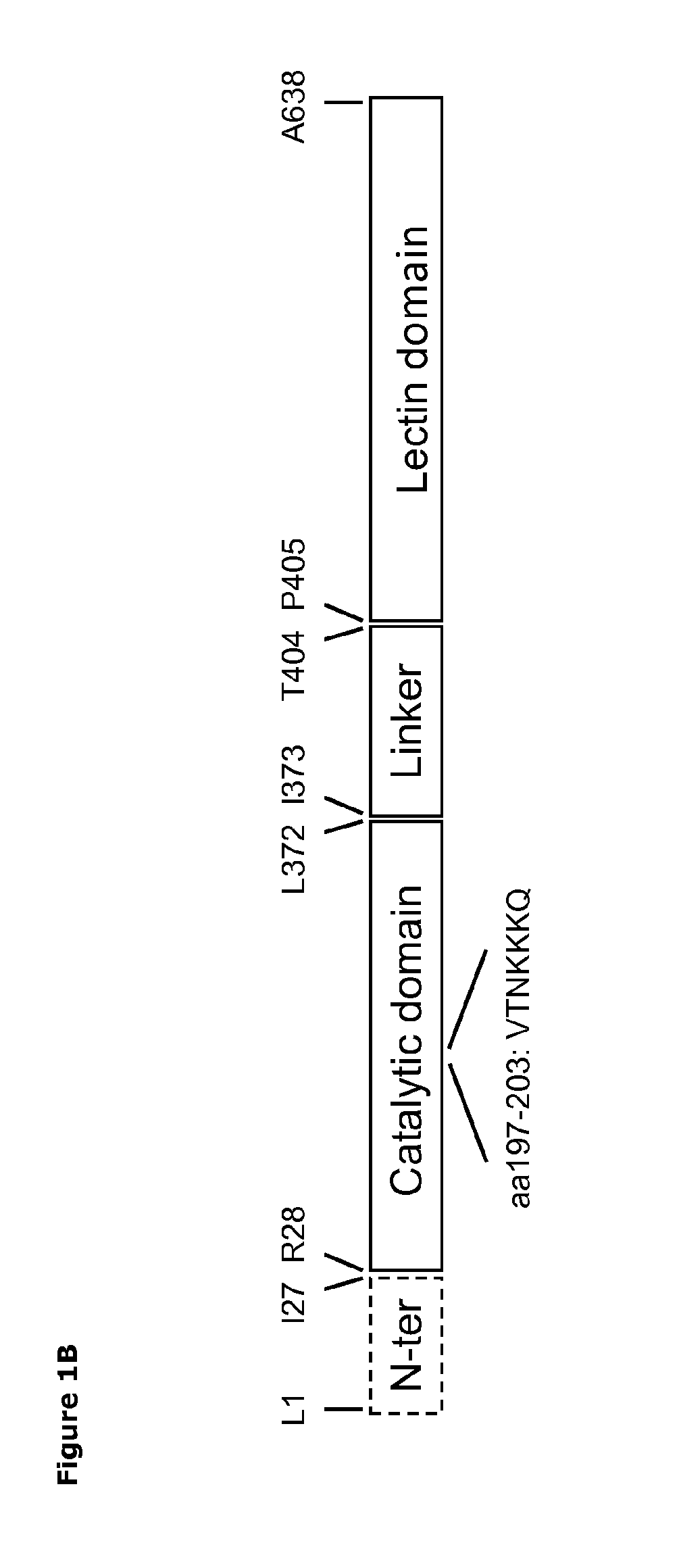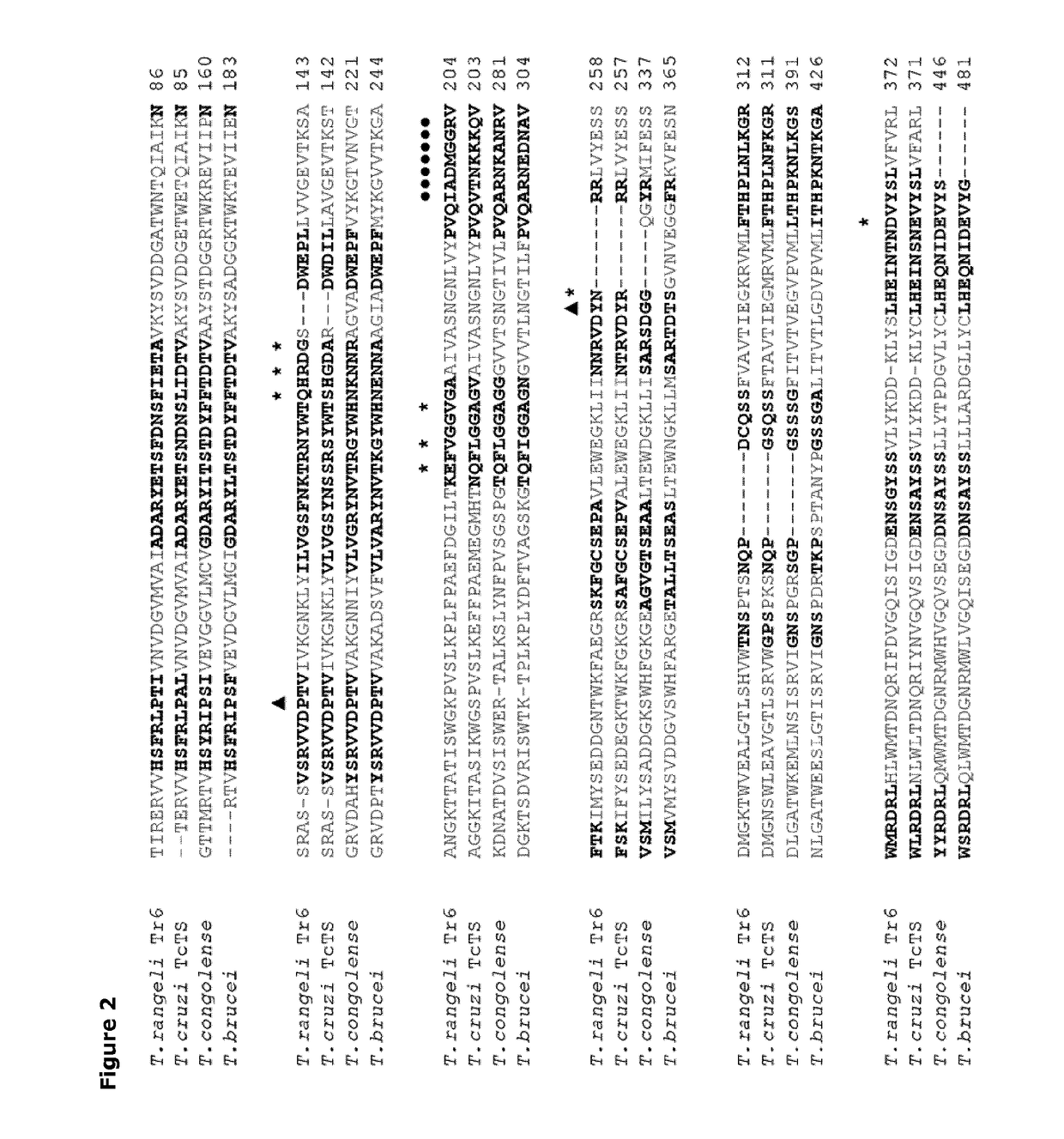Mutant sialidase having trans-sialidase activity for use in production of sialylated glycans
a technology of sialylated glycans and sialylated glycans, which is applied in the field of enzymes having transsialidase activity, can solve the problems of reducing the activity of hydrolases, reducing the therapeutic value of gos and fos, and reducing the therapeutic value of t. cruzi, etc., and achieving the effect of reducing the hydrolase activity
- Summary
- Abstract
- Description
- Claims
- Application Information
AI Technical Summary
Problems solved by technology
Method used
Image
Examples
example 2
Methods for Measuring the Trans-Sialidase and Sialidase Enzymatic Activity
2.1 Trans-Sialidase Activity Assay
[0067]Trans-sialidase activity was assayed as described previously [17] but with the following modifications. Reactions were performed in 50 mM phosphate-citrate (pH 6) at 30° C. using 2.9 μg / mL enzyme. The assay employed 1 mM cGMP-bound sialic acid as donor substrate and MU-Gal as the acceptor. MU-Gal at 0.5 mM was the highest final concentration to be tested due to its low solubility in aqueous solution. A solution of 87 mM MU-Gal in DMSO was diluted to 2 mM in 50 mM phosphate-citrate buffer (pH 6) immediately before preparing the reactions. When assaying crude enzyme preparations from P. pastoris, a background signal was observed, and attributed to cleavage of MU-Gal by endogenous β-galactosidase. This background signal could be removed by washing the column eight times with 440 μL of 5 mM HCl after sample application without desorption of the sialylated product and this wa...
example 3
a Positively-Charged Motif on the Border of the Binding Cleft of Sialidase Quenches its Hydrolytic Activity
3.1 Selection of Candidate Residues in Tr6 Sialidase for Mutation Screening
[0069]The catalytic domains of the sialidases were identified using NCBI Conserved Domain Search [10]. Pymol v1.3 (Schrödinger) was used to identify amino acids within 14 Å of the sialic acid binding site. The T. rangeli sialidase mutant Tr6 (see below) and trans-sialidases from T. cruzi (TcTS) (Uniprot ID Q26966), Trypanosoma congolense (Uniprot ID G0WJG3) and Trypanosoma brucei (Uniprot ID Q57XJ2) were aligned using ClustalW [11] (FIG. 2). Ranking of chemical difference between substituted amino acids in Tr6 vs. TcTS was done based on being first- or second sphere relative to the substrate and based on the polar / nonpolar and small / large distinction; such property-based selection turned out to correlate well with standard substitution matrices (BLOSUM62), i.e. the most unlikely substitutions were consid...
example 4 optimal
Reaction Conditions and Specific Activity of Tr13 Mutant Trans-Sialidase Catalyzed Trans-Sialylation
4.1 Optimized Reactions Conditions for Tr13 Mutant Trans-Sialidase
[0077]Optimal reaction conditions (pH, temperature, and concentration of donor and acceptor) were determined employing a quadratic central composite design. MODDE Version 7.0.0.1 (Umetrics AB, Umeå, Sweden) was used as a tool to design the experimental frame and to fit and analyze the data by multiple linear regression analysis. The pH regimes 3, 4 and 5, the incubation temperatures 20, 40 and 60° C. and the concentrations of the acceptor lactose of 117, 234 and 351 mM were tested. Reactions used a fixed concentration of cGMP-bound sialic acid of 8 mM in 15 mM phosphate-citrate buffer with specified pH values using 15 μg / mL Tr13. Lactose and cGMP were solubilized in buffer and pre-incubated at specific temperatures, before the reactions were initiated by addition of enzyme. The biocatalysis process was allowed to procee...
PUM
 Login to View More
Login to View More Abstract
Description
Claims
Application Information
 Login to View More
Login to View More - R&D
- Intellectual Property
- Life Sciences
- Materials
- Tech Scout
- Unparalleled Data Quality
- Higher Quality Content
- 60% Fewer Hallucinations
Browse by: Latest US Patents, China's latest patents, Technical Efficacy Thesaurus, Application Domain, Technology Topic, Popular Technical Reports.
© 2025 PatSnap. All rights reserved.Legal|Privacy policy|Modern Slavery Act Transparency Statement|Sitemap|About US| Contact US: help@patsnap.com



